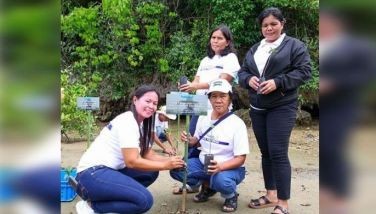Full alphabet used but more to come

National Economic and Development Authority (NEDA) director-general Arsenio Balisacan was quoted admitting the latest calamities to hit the country with catastrophic magnitude may impact again on the country’s poverty problem. Balisacan candidly conceded the recent series of natural calamities hitting the country this year could push more households into “transient†poverty.
As defined by the NEDA chief, “transient poor†refers to people previously not poor but who were suddenly pushed below the poverty line because of untoward incidents, including natural calamities.
The latest official statistics on poverty showed that 27.9 percent of Filipinos were living below the poverty line in the first semester of 2012.
We just had a Category 5 cyclone “Hainan,†locally named “Yolanda,†leaving a large swathe of destruction in the Eastern Visayas region: Samar, Leyte, Aklan, Antique, Capiz, Iloilo and Negros. It came less than a month after a magnitude 7.2 earthquake struck central Visayas. It caused so much destruction of public infrastructures and private structures in the provinces of Bohol and Cebu. This is not to mention loss of lives that could not be quantified in terms of statistics.
To his credit, Balisacan frankly conceded the government could not discount the possibility that some people living in the affected areas had been pushed into becoming poor and impoverished those already deep in poverty. Of course, the damage wrought on their properties and destruction if not disruption of sources of income are just some of the immediate effects.
Despite this sad picture, the NEDA chief expressed optimism the overall growth targets of the government for the country’s economy remain on track. Balisacan promised that NEDA would do an in-depth study of the impact of the earthquake and Yolanda on the country’s poverty incidence to come up with “safety nets†to better help the poor.
Unfortunately, these are the same provinces and regions which are considered among the “poorest†in the country. And sadly, some of these provinces are located in the so-called “typhoon†belt area in the Philippines. Their location makes them the most vulnerable to low-pressure areas that eventually develop into typhoons. Coming from the Pacific Ocean, these typhoons usually hit these provinces.
Municipalities from three Samar provinces constitute the top 10 poorest towns in Eastern Visayas. According to the National Statistical Coordination Board (NSCB) that recently released analysis culled from a 2009 survey, half of the top 10 poorest areas are located in Northern Samar, three from Eastern Samar, and two from Samar.
Silvino Lobos town in Northern Samar is the region’s poorest municipality as 65 percent of the population has an income insufficient to provide basic needs of families. Other areas in the top 10 poorest are (with corresponding poverty incidence) Jipapad, Eastern Samar (60.6%); Maslog, Eastern Samar (60.2%); Mapanas, Northern Samar (58.4%); Lope de Vega, Northern Samar (58.2%); San Jose de Buan, Samar (57.8%); Matuguinao, Samar (57.5%); Las Navas, Northern Samar (57.1%); Arteche, Eastern Samar (55.8%); and Catubig, Northern Samar (52.8%).
From the same NSCB study, Tacloban City in Leyte emerged as the least poor area with a poverty incidence of only 20.5 percent. Tunga and Isabel, both in Leyte followed with 23.1 percent and 23.7 percent poverty rates, respectively. Of the top 10 least poor areas, seven came from Leyte and three from Biliran province.
NSCB used the latest data available such as the 2009 Family Income and Expenditure Survey (FIES), 2009 Labor Force Survey (LFS), and 2007 Census of Population (PopCen) of the National Statistics Office to determine the city and municipal level poverty statistics.
On the other hand, NSCB listed Eastern Samar as the third among the 15 poorest provinces in the country. In the first six months of 2012, the poverty incidence in Eastern Samar reached as high as 59.4 percent. The highest is Lanao del Sur at 68.9 percent.
According to the Philippine Atmospheric, Geophysical and Astronomical Services Administration (Pagasa), our country is visited by at least 19 to 20 typhoons a year. From Pagasa records, this average was broken in 1993 when our country suffered 32 typhoons.
The socio-economic impact of the phenomenon called “climate change†cannot be ignored. Climate change adaptation and other disaster risk reduction measures are precisely being pushed to reduce the costly damage of these natural calamities to the nation’s economic life.
Such terms as “global warming,†countries that contribute hugely to “carbon prints†or air pollution that caused thinning of the earth’s ozone were again being debated at the Climate Conference being held in Warsaw, Poland. The Philippines became the focus of this year’s conference that sadly coincided with the onslaught of the deadliest typhoon in recent memory.
Following the modern Filipino alphabet that has 25 letters in naming typhoons, we have reached the last one named “Zoraida.†The 25th tropical typhoon that visited us this year so far was still in the Philippine area of responsibility as of press time yesterday.
Thus we go back to letter “A†for the next one that may develop for the remaining 48 days of this year. We had “Auring†on January 3 this year. Based from the auxiliary (or reserved) names of typhoons by Pagasa, the next typhoon will be called “Alamid.†By the way, the so-called “monster“ typhoon named “Yolanda†is effectively erased from the Pagasa list of typhoon names.
With the generous outpouring of international assistance from around the world, the administration of President Aquino vowed to spend every resource of the government to help the people recover from this latest calamity.
Per historical basis of weather monitoring by Pagasa, the Philippines could still experience three more typhoons before the end of this year. And Pagasa weather history indicates these three potential typhoons may still hit land. We may have already used the full alphabet but unfortunately, we have not seen the last one yet.
- Latest
- Trending




















